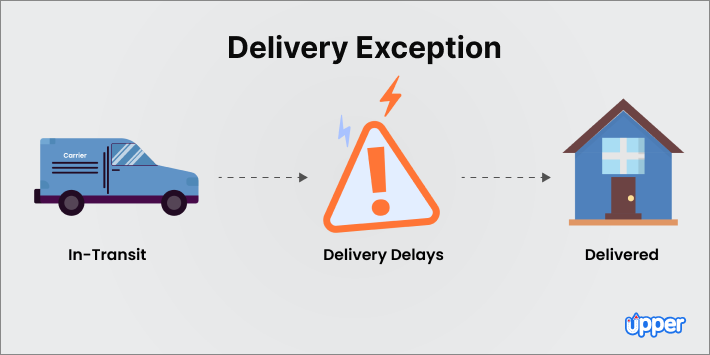Understanding Delivery Exceptions
What is a Delivery Exception?
A delivery exception occurs when a package cannot be delivered as scheduled due to unforeseen circumstances. This status indicates that something has temporarily stalled the delivery process, which may lead to delays. The reasons for a delivery exception can vary widely, from issues with the package itself to external factors affecting the delivery route.
Types of Delivery Exceptions
Delivery exceptions can be classified into several categories based on their causes:
- Address Issues: Incorrect or incomplete addresses can prevent successful delivery.
- Recipient Availability: If no one is available to receive the package, the delivery may not be attempted.
- Weather Conditions: Severe weather can delay transit and cause exceptions.
- Customs Delays: For international shipments, customs clearance issues may arise.
- Damaged Packages: If a package is damaged during transit, it may be held for further inspection.
- Technical Issues: Problems with scanning or tracking systems can also lead to exceptions.
How Delivery Exceptions Impact Consumers and Businesses
Delivery exceptions can significantly impact both consumers and businesses:
- Consumer Impact:
- Delays in receiving packages can lead to frustration and dissatisfaction.
- In some cases, consumers may need to take additional steps to resolve issues, such as contacting the carrier or arranging for redelivery.
- Business Impact:
- Companies may face increased costs due to reshipping or refunds.
- Poor handling of delivery exceptions can damage a business’s reputation and customer trust.
Common Causes of Delivery Exceptions
Understanding the common causes of delivery exceptions can help consumers and businesses mitigate their effects:
| Cause | Description |
|---|---|
| Incorrect Address | The provided address is incomplete or incorrect. |
| Recipient Not Available | No one is present to accept the package at the time of delivery. |
| Weather Conditions | Severe weather events disrupt transportation routes. |
| Customs Delays | International shipments face delays due to customs processing issues. |
| Damaged Packages | Packages damaged in transit may require inspection before delivery. |
| Technical Issues | Problems with tracking systems or scanning equipment can cause delays. |
How Carriers Handle Delivery Exceptions
Different carriers have specific protocols for managing delivery exceptions:
- FedEx:
- FedEx provides detailed tracking information and updates when a delivery exception occurs.
- They often attempt redelivery or redirect packages to secure locations if necessary.
- UPS:
- UPS will notify customers of any exceptions and provide updates on expected new delivery dates.
- They categorize exceptions into specific codes for better clarity.
- USPS:
- USPS will inform customers of delays due to holidays or other issues affecting service.
- They offer features like Informed Delivery® to help customers manage their packages.
- DHL:
- DHL focuses on international shipping and often faces customs-related delays.
- They provide tracking updates and work with customers to resolve issues promptly.
Managing Delivery Exceptions
When a delivery exception occurs, there are steps that both consumers and businesses can take:
For Consumers:
- Check Tracking Information: Regularly monitor tracking updates from the carrier for detailed information about the exception.
- Contact Customer Service: Reach out to the carrier’s customer service for clarification on the issue and potential solutions.
- Arrange for Redelivery: If applicable, schedule a new delivery attempt or pick up the package from a local facility.
For Businesses:
- Communicate Proactively: Inform customers about potential delays and provide updates on their orders.
- Review Address Accuracy: Ensure that shipping addresses are verified before dispatching packages.
- Implement Technology Solutions: Utilize order management systems that notify businesses of potential issues before they escalate.
Preventing Delivery Exceptions
To minimize the occurrence of delivery exceptions, consider implementing these best practices:
- Verify Addresses: Use address verification tools during checkout to reduce errors.
- Provide Clear Instructions: Ensure that shipping labels include all necessary information in legible formats.
- Communicate with Customers: Keep customers informed about their orders and any potential delays.
Conclusion
Understanding delivery exceptions is crucial for both consumers and businesses involved in shipping and logistics. By recognizing the causes and implications of these exceptions, stakeholders can take proactive measures to mitigate their impact, ensuring smoother transactions and improved customer satisfaction.
Frequently Asked Questions (FAQs)
- What does it mean if my package has a delivery exception?
- A delivery exception means that there has been an issue preventing your package from being delivered as scheduled.
- Will I still receive my package if there is a delivery exception?
- In most cases, yes; however, it may cause delays in your package’s arrival.
- What should I do if my package shows a delivery exception?
- Check tracking details for information on the issue, contact customer service if needed, and arrange for redelivery if applicable.
- Can I prevent delivery exceptions?
- Yes, by verifying addresses at checkout and ensuring clear communication with carriers.
- Where can I find more information about shipping exceptions?
- For further reading on shipping exceptions, you can refer to Wikipedia.
Additional Resources
For more insights into managing shipping processes effectively, consider exploring government resources or educational websites that focus on logistics management and consumer rights in shipping practices.






More Stories
Where to Watch USMNT vs Jamaica National Football Team
How I Met My Monster
How Should a Ring Fit